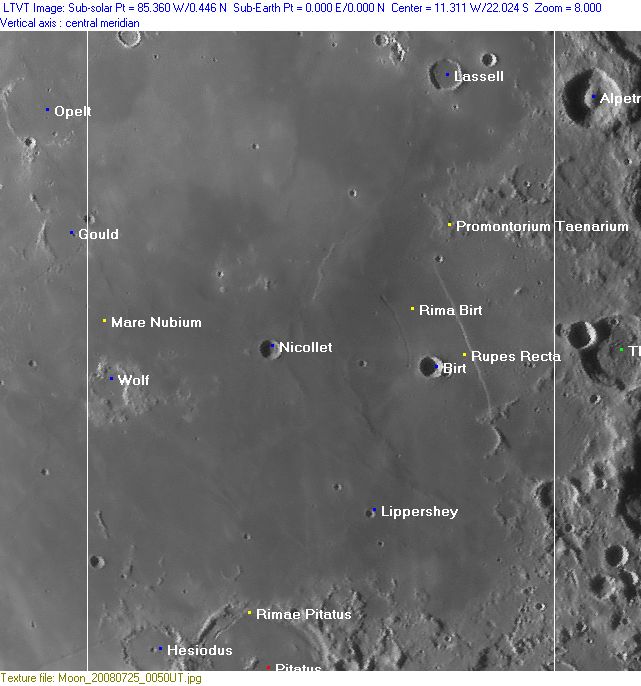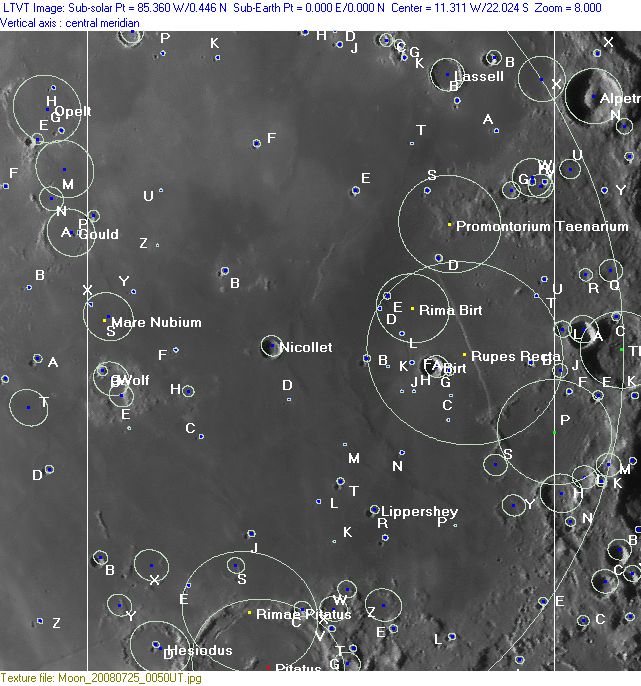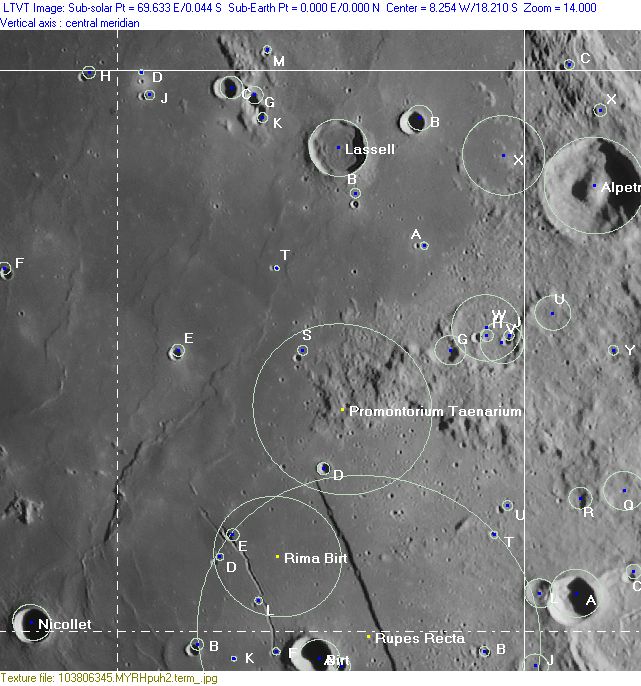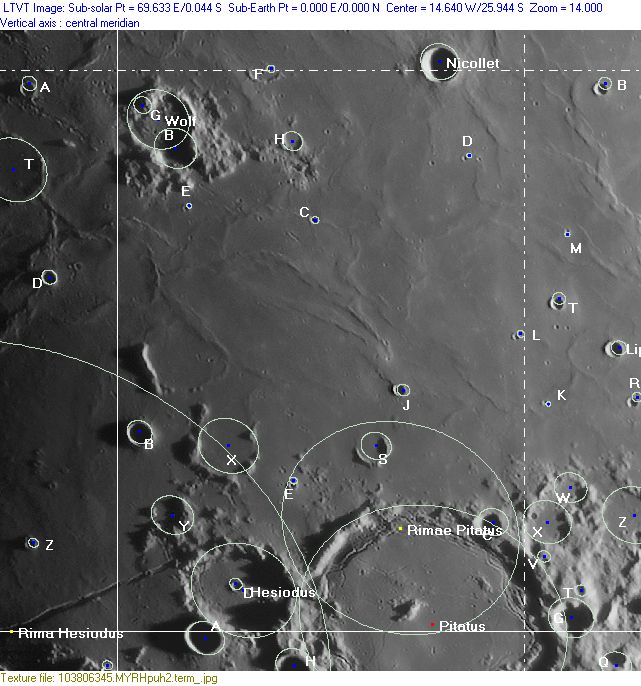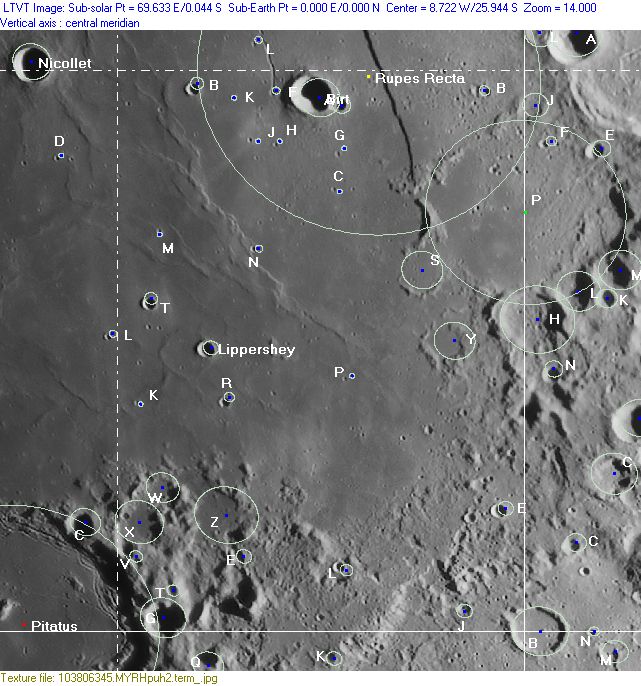Rükl 54
Contents
Rükl Zone 54 - BIRT
Neighboring maps on the Rükl Nearside Map:
Table of Contents
[#Rükl Zone 54 - BIRT Rükl Zone 54 - BIRT]
[#Rükl Zone 54 - BIRT-Photographic Map Photographic Map]
[#Rükl Zone 54 - BIRT-Named Features Named Features]
[#Rükl Zone 54 - BIRT-Lettered Crater Locations Lettered Crater Locations]
[#Rükl Zone 54 - BIRT-Lettered Crater Locations-Full zone with lettered craters Full zone with lettered craters]
[#Rükl Zone 54 - BIRT-Lettered Crater Locations-Lettered craters by quadrants Lettered craters by quadrants]
[#Rükl Zone 54 - BIRT-Additional Information Additional Information]
[#Rükl Zone 54 - BIRT-The Lassell Massif: remarkable color difference near Lassell C The Lassell Massif: remarkable color difference near Lassell C]
[#Rükl Zone 54 - BIRT-The Cinder Cone near Lassell D and Lassell J The Cinder Cone near Lassell D and Lassell J]
| 54 |
||
Photographic Map
(This map is based on an Earth-based photograph that has been computer-corrected to zero libration. The vertical white lines indicate the left and right boundaries of the Rükl rectangle)
Background image source
Named Features
- Ancient Thebit (an unofficial name; the ruins of the large crater surrounding Rupes Recta, west of Thebit).
- Birt (J.Hewelcke's Insula Cyprus).
- Blue crater (a nickname from D.Caes for the slightly bluish colored crater Gould P at the northeastern part of Gould's rim).
- Cinder Cone (NASA's unofficial name for the exceptionally dark craterlet west of the Lassell Massif, see Additional Information below).
- Dorsa Pitatus J - Wolf C (an unofficial name from D.Caes for the system of wrinkle ridges between Pitatus J and Wolf C, in Mare Nubium, north of Pitatus itself).
- Dorsa Wolf S (an unofficial name from D.Caes for the more-or-less circle shaped system of wrinkle ridges officially known as Wolf S).
- Dorsum Lippershey N (an unofficial name from D.Caes for the wrinkle ridge running across the craterlet Lippershey N, northeast of Lippershey itself).
- Dorsum Nicollet Psi (an unofficial name from D.Caes for the pronounced wrinkle ridge northeast of Nicollet itself) (according to chart 82 in the Times Atlas of the Moon this wrinkle ridge contains the hill Nicollet Psi).
- Elger's oval, and straight fault (an "unofficial name" from D.Caes for a strange oval-shaped formation and a so-called straight fault southwest of Lassell, discovered by T.G.Elger and more-or-less "confirmed" by others, see pages 102-103 in H.Hill's A Portfolio of Lunar Drawings).
- Garcia-Gomez (a disallowed name from H.P.Wilkins for the bowl shaped crater Alpetragius B east-northeast of Lassell).
- Garcia-Gomez's mob (a nickname from D.Caes for the small cluster of craterlets immediately north of Garcia-Gomez, aka Alpetragius B).
- Hesiodus (note: for the location of the well-known concentric crater Hesiodus A, see Chart 64).
- Insula Rhodus (J.Hewelcke's disallowed name for the bright area at Nicollet, plus Nicollet Delta, etc.) (depicted on J.Hewelcke's map as some sort of lozenge).
- Lassell (J.Hewelcke's Insula Lesbos).
- Lassell Massif (C.A.Wood's name for the yellowish colored elevation northwest of Lassell, see Additional Information below, and also Chart 43).
- Lippershey
- Mare Nubium (Van Langren's Mare Borbonicum).
- Mare Pamphylium (J.Hewelcke's disallowed name for the southern part of Mare Nubium).
- Nicollet
- Nicollet Epsilon (hill immediately west of Nicollet).
- Nicollet Theta (hill north of Nicollet).
- Nicollet Psi (hill or ridge northeast of Nicollet) (there's a low-albedo spot just north of Nicollet Psi, more-or-less of the same kind as Mons Moro on Rukl 42).
- Pitatus (J.Hewelcke's Mare Mortuum).
- Profatius (a disallowed name from Riccioli for Nicollet B).
- Promontorium Taenarium (note: J.Hewelcke's Prom.Taenarium was the IAU's Guericke B).
- Rima Birt
- Rimae Pitatus
- Roy (F.C.Lamech's disallowed name for the bowl shaped crater Hesiodus B).
- Rupes Recta (sometimes called The Railway).
- Sinus Strymonicus (J.Hewelcke's disallowed name for the eastern part of Mare Nubium).
- Stag's Horn Mountains (an unofficial name).
- Wolf (Van Langren's Robervalis, J.Hewelcke's Insula Carpathos, Riccioli's Munosius).
Lettered Crater Locations
(click on the thumbnails to view full-sized images; use browser BACK button to return to this page)
Full zone with lettered craters
Lettered craters by quadrants
(the dashed white lines are the centerlines of the Rükl zones)
| North West |
North East |
| South West |
South East |
Additional Information
- Other online descriptions of features in this Rükl map section:
- The irregular cluster of hillocks and craterlets to the northwest of Lassell (the Lassell Massif, of which the largest craterlet is Lassell C) was investigated from orbit during the mission of Apollo 16 in april 1972. Apollo 16's Command Module Pilot (CMP) Ken Mattingly (in CSM Casper) noticed a peculiar yellowish coloration in this cluster. It is interesting to know that the Lassell Massif's coloration is also observable through telescopes (before, during, and after Full Moon). See also: Colored Regions on the Moon's Surface (Part 1). Research: Danny Caes
The Lassell Massif: remarkable color difference near Lassell C
Noticed and described by CMP Ken Mattingly during the mission of Apollo 16:
- 147:59:22 Ken Mattingly: I'm looking at Lassell C and the little highlands clump that's by it. And - remember, we had a red and a blue color difference, and right now the Southern Pease with a crater in it is sort of a - a tan color, and the Northern Pease is a gray. When I look at the mare, I see a big swatch of - of the tan-colored mare down to the south that goes over towards Guericke. And I see a - a tongue of darker gray material. The area around Lassell C has the tan tone to it. Then it goes out about as far as our little cone and the little bright crater next to it. That's about the outer limit - maybe just a little beyond. Then there's a patch of the - of this tan stuff that's down to the south that about lines up with the big Achaean rille that's over to the southeast. Then there's a patch in the gray-colored mare down inside of that. It's just a little circular piece. In looking at the Lassell C feature - a look at it in detail - it appears to me that this tan stuff on the south end of it has fewer craters than the stuff on the north, although not an awful lot, but there's little pitted craters all over the northern part. They're not on the southern parts and there are a couple of light, streaked bands that appear in the southern clump that you don't see in the north.
Source: Apollo 16 Flight Journal by David Woods and Tim Brandt.
- Note: In the preceding, "Southern Pease" and "Northern Pease" appear to be transcription errors for "southern piece" and "northern piece". The coloration near Lassell C is also noticeable through telescopes on Earth. Many photographers have made interesting RGB-images of this remarkable colored spot.
- See also the LROC's WAC albedo/color map; close up of the Lassell C region: http://bit.ly/1xbMvgV
The Cinder Cone near Lassell D and Lassell J
- The bright ray-craterlet Lassell D, the common bowl-shaped craterlet Lassell J, and the unusually dark craterlet southwest of Lassell D and J (the so-called Cinder Cone) are described and depicted in NASA SP-362; APOLLO OVER THE MOON; A VIEW FROM ORBIT, Chapter 4: The Maria (Part 3), Figure 88 (two versions of orbital Hasselblad frame AS16-120-19237: a small one and an enlarged detailed view of the three craterlets as a cluster).
- The unusually dark craterlet (the Cinder Cone) southwest of Lassell D and J is an excellent test object for telescopic observers of the Full Moon.
- According to several dedicated moonobservers of the past, the bright ray-craterlet Lassell D appears to be of the same nature as Linné, Posidonius Gamma, and Werner D (possible changes of brightness in their ejecta-blankets).
- Most of today's photographers of the Full Moon's disc are unaware of the Cinder Cone's dark appearance on their webcam images. But... once they know the pinpoint location of it, they can't miss it! Good luck!
- Satellite crater Lassell D is on the ALPO list of bright ray craters and on the ALPO list of banded craters (note: Lassell D is only 2 km in diameter).
This page has been edited 1 times. The last modification was made by - tychocrater tychocrater on Jun 13, 2009 3:24 pm - mgx2
